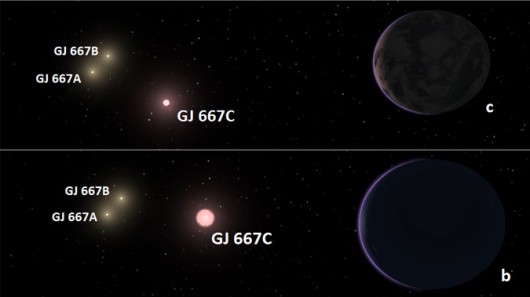
An artistic conception of the triple star system where GJ667Cc resides (Image: Carnegie Institution for Science / Guillem Anglada-Escud)
An international team of scientists led by Professors Guillem Anglada-Escudé and Paul Butler from the Carnegie Institution for Science in the U.S. has discovered a potentially habitable Super-Earth that's "just" 22 light years away. The new Super-Earth has a mass that is 4.5 times larger than that of our planet and it revolves around its parent star in 28 days - a star that is significantly smaller than ours. This remarkable new discovery suggests that habitable planets could exist in a wider variety of environments than previously believed.
Of the 750-odd exoplanets (extrasolar planets) discovered so far only very few can be considered "Super-Earths." This newly discovered example called GJ667Cc is rocky like Earth and is rich in heavy chemical elements such as iron, carbon and silicon. Positioned at a distance from Earth of 22 light years, corresponding to a bit over 129 trillion miles (209 trillion km), the planet can be considered to be on Earth's doorstep. Furthermore the planet is expected to absorb about the same amount of energy from its star that our Earth absorbs from the Sun. Surface temperatures are therefore expected to be similar to Earth's and the existence of water is quite possible.
"This planet is the new best candidate to support liquid water and, perhaps, life as we know it," said Anglada-Escudé.
The team made the discovery using public data from the European Southern Observatory, incorporated with new measurements from the Keck Observatory's High Resolution Echelle Spectrograph and the new Carnegie Planet Finder Spectrograph at the Magellan II Telescope.
The team is also hopeful that within the triple star system where GJ667Cc resides, there may be the presence of a gas-giant planet and an additional super-Earth with an orbital period of 75 days. However, further observations are needed to confirm these two possibilities.
"With the advent of a new generation of instruments, researchers will be able to survey many M dwarf stars for similar planets and eventually look for spectroscopic signatures of life in one of these worlds," explained Anglada-Escudé.
Source: Carnegie Institution for Science